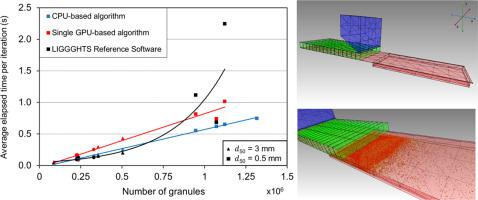当前位置:
X-MOL 学术
›
Powder Technol.
›
论文详情
Our official English website, www.x-mol.net, welcomes your
feedback! (Note: you will need to create a separate account there.)
DEM-based modelling framework for spray-dried powders in ceramic tiles industry. Part II: Solver implementation
Powder Technology ( IF 4.5 ) Pub Date : 2021-01-01 , DOI: 10.1016/j.powtec.2020.08.095 J.M. Tiscar , A. Escrig , G. Mallol , J. Boix , F.A. Gilabert
Powder Technology ( IF 4.5 ) Pub Date : 2021-01-01 , DOI: 10.1016/j.powtec.2020.08.095 J.M. Tiscar , A. Escrig , G. Mallol , J. Boix , F.A. Gilabert

|
Abstract In the preceding Part I, a combined experimental-numerical study to characterize fine spray-dried powder used in the ceramic tile pressing process was presented. In the present Part II, the algorithm proposed by (Mazhar, 2011) to solve the numerical simulation of powder dynamics through the Discrete Element Method (DEM) was extended. In this paper, the original algorithm was adapted for efficient use on multi-core CPUs and a single GPU. In both cases, history-dependent contact models were considered. The efficiency of the algorithms was compared among them and with LIGGGHTS, a reference software package for particle simulation using DEM. The results demonstrated a higher performance of the codes developed compared to LIGGGHTS, particularly in demanding scenarios with a large number of particles (more than 1 million) of small size (median diameter in volume less than 1 mm). In particular, the CPU-based algorithm was suitable for simulating the mould filling in ceramic tiles industry.
中文翻译:

基于 DEM 的瓷砖行业喷雾干燥粉末建模框架。第二部分:求解器实现
摘要 在前面的第一部分中,介绍了表征瓷砖压制过程中使用的细喷雾干燥粉末的实验-数值组合研究。在当前的第二部分中,扩展了 (Mazhar, 2011) 提出的通过离散元法 (DEM) 求解粉末动力学数值模拟的算法。在本文中,原始算法适用于在多核 CPU 和单个 GPU 上的高效使用。在这两种情况下,都考虑了历史相关的接触模型。算法的效率在它们之间进行了比较,并与使用 DEM 进行粒子模拟的参考软件包 LIGGGHTS 进行了比较。结果表明,与 LIGGGHTS 相比,开发的代码具有更高的性能,特别是在具有大量小尺寸(体积中值直径小于 1 毫米)颗粒(超过 100 万个)的苛刻场景中。特别是基于CPU的算法适用于模拟瓷砖行业的模具填充。
更新日期:2021-01-01
中文翻译:

基于 DEM 的瓷砖行业喷雾干燥粉末建模框架。第二部分:求解器实现
摘要 在前面的第一部分中,介绍了表征瓷砖压制过程中使用的细喷雾干燥粉末的实验-数值组合研究。在当前的第二部分中,扩展了 (Mazhar, 2011) 提出的通过离散元法 (DEM) 求解粉末动力学数值模拟的算法。在本文中,原始算法适用于在多核 CPU 和单个 GPU 上的高效使用。在这两种情况下,都考虑了历史相关的接触模型。算法的效率在它们之间进行了比较,并与使用 DEM 进行粒子模拟的参考软件包 LIGGGHTS 进行了比较。结果表明,与 LIGGGHTS 相比,开发的代码具有更高的性能,特别是在具有大量小尺寸(体积中值直径小于 1 毫米)颗粒(超过 100 万个)的苛刻场景中。特别是基于CPU的算法适用于模拟瓷砖行业的模具填充。











































 京公网安备 11010802027423号
京公网安备 11010802027423号